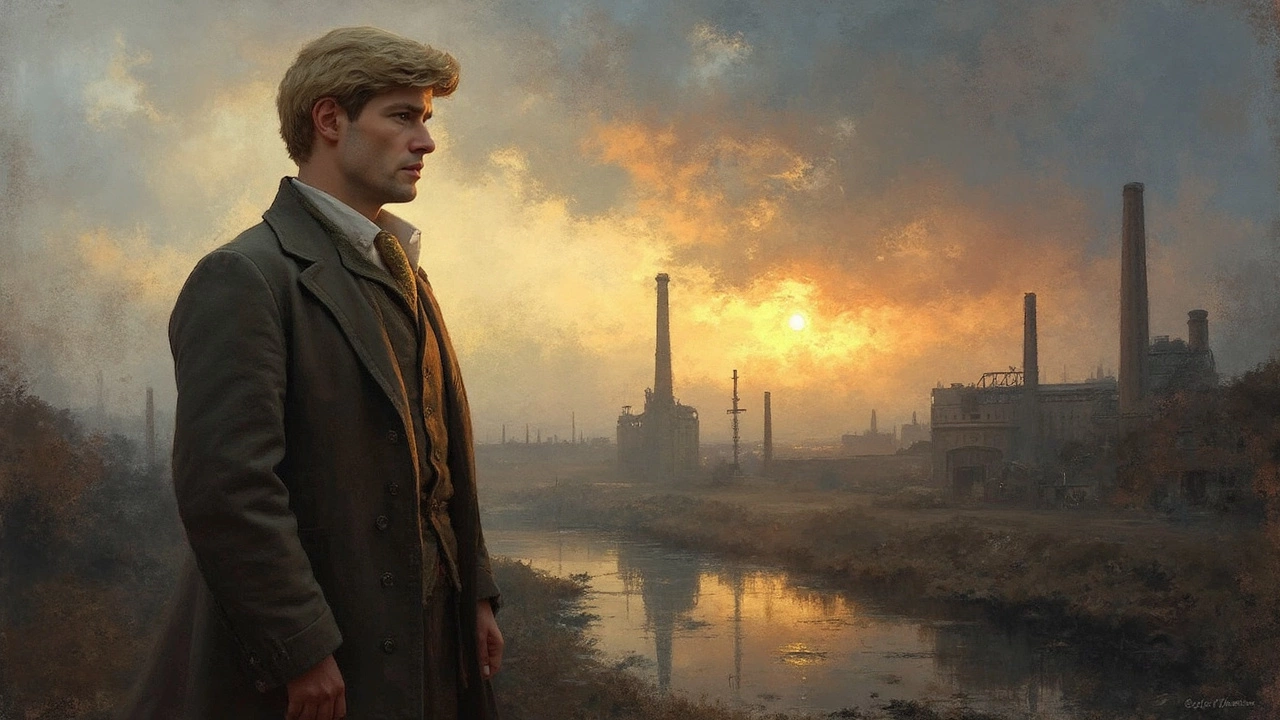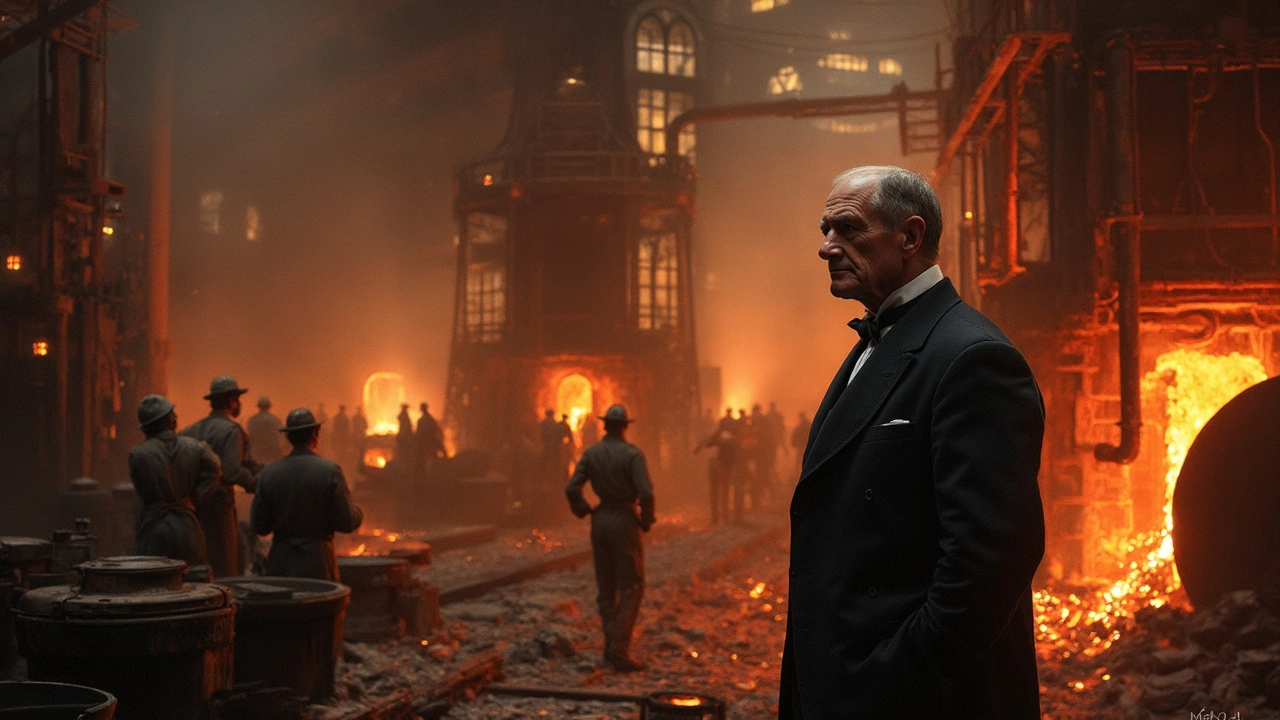Richest Titan in Steel: Andrew Carnegie's Journey

Andrew Carnegie wasn't born with a silver spoon in his mouth. In fact, his early life in Scotland was the exact opposite. Imagine a young boy, hustling around just to make ends meet for his family. Fast forward a bit, he's in America, setting the stage for an empire. The journey from being a bobbin boy in a cotton factory to owning the largest steel manufacturing business sounds straight out of a movie, right?
Steel was the name of the game, and Carnegie played it like a maestro. Through innovation and gutsy business moves, he didn't just join the industry—he redefined it. His knack for pinpointing opportunities within the sector and scaling them, stands as a lesson for every up-and-coming entrepreneur today. Ever wonder how he managed to sell his steel business for a jaw-dropping $480 million in the early 1900s? Yep, that's a number with more zeros than you might expect.
Oh, and those game-changing innovations? They weren't just buzzwords. Carnegie embraced the Bessemer process, turning steel production into an efficient, cost-effective juggernaut. That's how Henry Ford was able to build all those Model Ts—the steel was cheap and plentiful. Talk about a guy who's directly or indirectly shaped modern civilization as we know it.
- The Humble Beginnings
- Building an Empire
- Innovations that Changed the Game
- Wealth Beyond Imagination
- Carnegie's Lasting Legacy
The Humble Beginnings
Andrew Carnegie’s story kicks off in a tiny hometown in Dunfermline, Scotland. Born on November 25, 1835, young Andrew lived in a modest weaver’s cottage with a single all-purpose room. His family wasn’t rolling in riches; they were more like making do with what they had.
The Carnegies decided to make a big leap across the pond to America in 1848, seeking better opportunities. Andrew was just 13, yet he quickly realized if he wanted to get somewhere, he'd have to hustle. His first job was as a bobbin boy in a cotton factory, making a measly $1.20 a week. But every penny counted for his family back then.
Despite the early hardships, Carnegie was fueled by a thirst for knowledge and a desire to succeed. He grabbed every chance to educate himself, spending evenings at university classes and even borrowing books from a local advocate who’d taken an interest in him. Ironically, this self-driven learning spirit would later translate into his philanthropic efforts towards libraries.
"You cannot push anyone up a ladder unless he is willing to climb a little himself." - Andrew Carnegie
By 1853, Carnegie managed to land a job as a telegraph messenger boy. He had an uncanny ability to memorize all the locations of the Pittsburgh businesses he served, which soon found him promoted to a telegraph operator. These early work experiences built his foundational understanding of business and communication, setting him up for future stardom in the steel industry.
These humble beginnings may not seem glamorous, but they forged the grit and determination Carnegie would need to revolutionize the world of steel manufacturing later in his life.
Building an Empire
Andrew Carnegie didn't just stumble into the steel industry; he paved a meticulously calculated road to get there. After a stint working on the railroads, where he learned the ins and outs of American business, he saw an opportunity. Railroads needed steel for their tracks, signaling an emerging demand for this robust material.
Here's the kicker: instead of selling steel to the rail companies, Carnegie thought bigger. He started his own steel manufacturing company in 1873, the Carnegie Steel Company, capitalizing on the industrial boom. With an uncanny ability to spot trends before they took off, Carnegie utilized the latest technologies and cut-throat cost-cutting strategies to dominate the industry.
One of Carnegie's smartest moves was focusing on vertical integration. Put simply, he bought up not just the steel mills, but also the iron ore fields and the ships and railways needed to transport materials. This approach slashed costs and maximized profits, making his company more competitive than any other.
Carnegie's empire rapidly expanded, thanks to his focus on innovation and efficiency. He embraced the Bessemer process, which revolutionized steel production by significantly reducing the time and labor involved. By 1892, Carnegie Steel was producing more steel than all of Great Britain's combined output. Impressive, huh?
In 1901, Carnegie sold his company to J.P. Morgan for a whopping $480 million, a dead giveaway that Andrew was a force to be reckoned with. His steel dynasty had turned Pittsburgh into the steel capital of the world and forever changed the American landscape. And just like that, he shifted from a business titan to a philanthropist, but that's another story.

Innovations that Changed the Game
When you think of groundbreaking changes in the steel manufacturing industry, Andrew Carnegie is a name that stands tall, largely due to the innovations he embraced and promoted. The most impactful of these was the Bessemer process, which revolutionized steel production by making it faster and cheaper. This process involved blowing air through molten iron to remove impurities, a move that cut costs and ramped up production speed like never before.
But Carnegie didn't stop with just one new tech trick. He pushed the envelope further with vertical integration. What's that, you ask? He owned not just the steel mills but also the raw materials, like iron mines and coal fields, and even the railroads to transport them. It was like having every piece of the puzzle in the palm of his hand, which drastically cut expenses and boosted his profits.
Another cool thing Carnegie did was to invest in the latest machinery and techniques. For example, he introduced open-hearth furnaces, which allowed for greater control over steel quality and composition. This consistent quality made his steel more reliable, helping build trust with his customers.
Carnegie also had this talent for spotting and nurturing talent, knowing that brains and skills were as important as machines. He surrounded himself with some of the brightest business minds, which helped his empire not just survive but thrive in unpredictable market conditions.
The result? By the 1890s, Carnegie's steel output surpassed that of the entire British Empire, cementing his position as a leader in the steel industry. Talk about a guy who truly changed the game, one innovation at a time!
Wealth Beyond Imagination
Andrew Carnegie had riches most folks can only dream about. At his peak, his fortune was more massive than the GDP of several small countries back then. Can you believe that at one point, he was making around $23 million a year? And that's back in the early 1900s, which is like a bazillion in today's money!
If you’re wondering what $480 million is worth today, it translates to an eye-popping equivalent of over $14 billion. That's why he was known as the richest man in the steel industry. But Carnegie wasn't just hoarding his wealth. He had a vision for it.
"The man who dies rich, dies disgraced." – Andrew Carnegie
This guy was the original philanthropist. He believed in giving it all away and founded numerous libraries, universities, and got into some heavy-duty philanthropy. He gave away about 90% of his fortune, which was unheard of at the time. His philosophy was pretty straightforward: use your cash to better society. And he did just that.
Check out this mind-blowing fact: he established over 2,500 libraries worldwide. Imagine the pages of knowledge he helped spread! Plus, his donations weren’t just paper promises; they genuinely shifted the landscape in education and public welfare.
| Year | Total Donations | Equivalent in Today's Dollars |
|---|---|---|
| 1919 | $350 million | $5.3 billion |
Walking in the streets today, you might just find a Carnegie Hall or a Carnegie Mellon University, reminders of how his wealth continues to make an impact. This is the legacy of someone who turned a steel empire into a beacon of global societal change.

Carnegie's Lasting Legacy
After dominating the steel industry and becoming the richest man in the steel industry, Andrew Carnegie left a mark that went way beyond business. His legacy wasn't just built on cold, hard cash; it was his vision for making the world a better place that really made waves. When you think about it, the guy gave away a huge chunk of his fortune to various causes. He believed in the notion that the wealthy had a responsibility to give back, which later became known as the 'Gospel of Wealth.'
Carnegie took philanthropy to another level. His money built libraries and educational institutions around the globe. If you’ve walked past a local library or attended a uni that suddenly got a scholarship fund, there’s a good chance Carnegie's money played a part. He funded over 2,500 libraries worldwide. Can you imagine the number of minds inspired in those reading rooms?
The legacy persists in the arts and sciences too. With the creation of Carnegie Hall and the Carnegie Institution for Science, he ensured that both creativity and innovation could flourish. These places aren't just old buildings; they are living testimonies to an era and a vision that championed human progress.
And if you're wondering where to still see his impact today, think about the Carnegie Endowment for International Peace. Even now, it's one of the top think tanks that deal with global peace issues. Talk about a man ahead of his time, right? Carnegie managed to weave his ideals into the very fabric of society.
Here's a snapshot of Carnegie's philanthropic impact:
- Libraries: Over 2,500 libraries funded worldwide.
- Education: Established institutions such as Carnegie Mellon University.
- Science & Arts: Funded the Carnegie Institution for Science and Carnegie Hall.
- Peace: Founded the Carnegie Endowment for International Peace.
For someone once labeled as tough-nosed and relentless in business, Carnegie’s ability to pivot towards philanthropy is a massive lesson in legacy-building. It’s a blueprint that today’s moguls still study, hoping to leave behind a legacy that isn't measured in dollars and cents alone, but in societal good.





